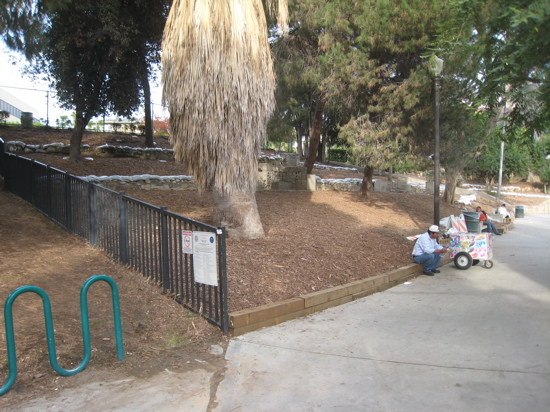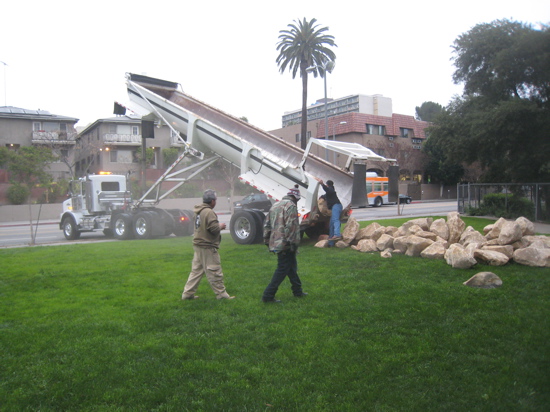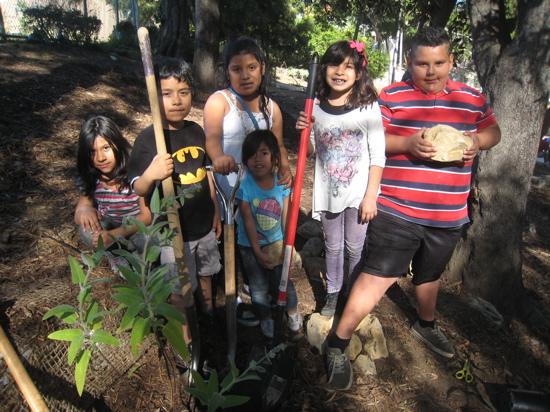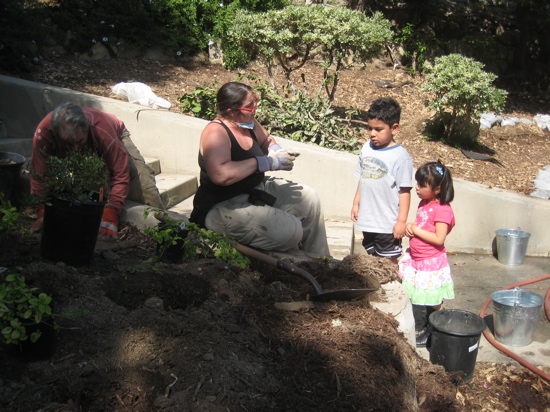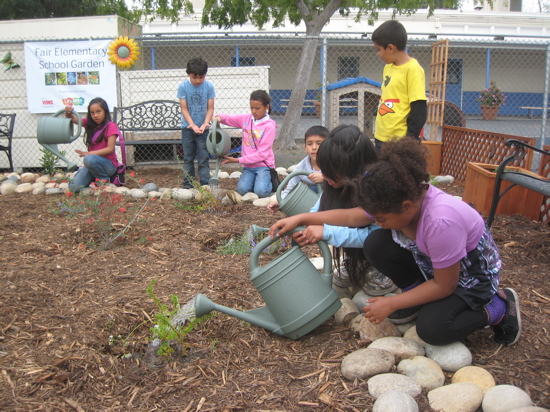L.A.'s BEST after-school program is all about enriching the lives of students and their communities, and the ripples of this remarkable program recently spread to a challenging project in MacArthur Park known as "The Diamond in the Dust."
Funded by a $10,000 grant from the City of L.A. Office of Community Beautification and directed by the Theodore Payne Foundation, the project was to transform a dusty slope into a Nature Play Garden for the children of the surrounding communities. Landscape architect Amy Nettleton donated an inspired plan that included an elderberry "cave," boulders, fragrant paths of pitcher sage, islands of deer grass and shady havens among coffeeberry, bush anemone and lilac. The plan was beautiful and, on April 7 of this year, the garden was installed, bringing some of the natural beauty of California to a very urban part of Los Angeles.
The project had taken nearly three years to realize. It was a good thing that, on installation day, Raul Flores, my partner on the project, and I couldn't see into the future -- the very near future.
Dozens of people from City of L.A. Department of Recreation and Parks, the Theodore Payne Foundation, the Community Awareness Network and private companies had made the Nature Play Garden possible. In this time of severe cutbacks, the project was a model of cooperation to achieve a result that, ordinarily, would have cost upwards of a hundred thousand dollars for installation and maintenance. Everyone worked together to move the project forward through the required steps: Approval of site and implementation plans by the Board of Recreation and Parks; Right-of-Entry Permits and LiveScan clearances for volunteers; soil conditioning through mulch and fiberscape by the Department of Recreation and Parks; bids from highly-insured companies to supply, transport and place the boulders; and Theodore Payne Foundation maintenance of the more than 150 native plants forced to remain in their containers due to project delays. Countless small, but important, details compounded these basic steps and, all the while, personnel in the Office of Community Beautification and the Department of Recreation and Parks assisted with the intricacies of the bureaucratic process.
Finally, private-sector goodwill launched the actual implementation of the project: at a cut-rate price, Santa Barbara Bobcat provided the sandstone boulders for the historic site. At very short notice, Joshua Contracting came to the rescue not just once, but twice, with boulder delivery and placement. And Wilshire/Union Home Depot employees patiently helped locate unusual quantities of items and delivered the much-needed goods to the Park free-of-charge.
On April 7 -- installation day -- volunteers from the Theodore Payne Foundation and the local community transformed the bare, dusty slope into a "diamond" -- a lovely garden refuge complete with seating areas and winding paths. Throughout the day, families from the neighborhood helped with digging holes in the compacted hillside, moving mulch, installing plants and watering, all the while beaming smiles of appreciation and asking questions about the butterflies and birds the native plants would attract. The palpable goodwill from the community on installation day erased any previous frustration with bringing the project to fruition.
The installation of the garden was a triumph of perseverance and dedication for everyone involved. Afterwards, Raul and other volunteers from the Community Awareness Network embarked on the maintenance of the garden, watering by hand once per week, watching over the garden daily and sharing information about the plants with children and parents at the playground. I felt hopeful about the garden's future because of the dedication and goodwill of so many members of the local community.
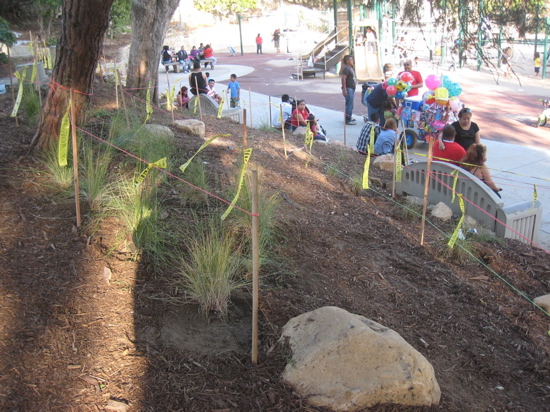
Five weeks later, I stopped by the Park to see how the garden was faring. Raul had told me that some vandalism had occurred, but nothing prepared me for what I saw: Less than five percent of the new plantings remained. Along the upper tier of the approximately 100-foot-wide slope, a swath of Catalina currants: gone. Baby redbud trees around the seating areas: gone. A dark green dell of bush anemone to delight the eye with extravagantly beautiful white flowers: gone. Along the middle tier of the slope, California lilac and coffeeberry bushes: gone. Only craters and hacked plant stems remained, the stems still attached to root balls half pulled out of the ground. On the lower tier next to the playground, not one of the dozen California buckwheat bushes remained.
I sat down on one of the benches and stared at the garden. I felt angry and heart-broken. It was clear that some of the plants had been dug out of the hillside, presumably for home gardens, while other plants had been yanked out. Walking around the area, I found desiccated husks of plants dozens of yards away, their root balls still attached. I hoped that the home gardeners would know how to take care of the plants, neither over- nor under-watering, and wondered about the mentality of those who found satisfaction in harming a community garden. Above all, I was upset that a play area intended to be a haven for inner-city children had been largely destroyed -- a play area that was supposed to teach stewardship of the planet. And in this time of climate change and ever-increasing concern about habitat loss, plummeting populations of birds and pollinators and the availability of fresh water, it was evident that the people who hurt the garden had no real idea of the damage they were doing, no real idea of what is at stake and how this garden was a small attempt to put a little something right.
That day, I wanted nothing more to do with the project. It is uncharacteristic of me to quit on anything, but I felt justified in making this garden the exception.
The next day, still reeling from the destruction, I visited the native and edible garden at Fair Avenue Elementary School in North Hollywood. The garden had recently been installed through a generous grant from Vons and the labor of more than 50 Vons volunteers and L.A.'s BEST and Theodore Payne staff, transforming a 30' by 50' patch of scraggly but tenacious Bermuda grass into a burgeoning oasis of native cherry, buckwheat, sage and currant, with perimeter boxes of tomatoes, sugar snap peas and mint. When I arrived, L.A.'s BEST students were on their hands and knees in the garden, working hard to remove strands of Bermuda that managed to find their way between the overlapping pieces of cardboard and the five inches of mulch deposited to kill the grass. Students crouched around the baby native plants, gently pulling back the branches to check for Bermuda in the plant wells. The students solemnly and enthusiastically embraced their role as caretakers of the new garden. They weeded and watered with a conscientiousness that was as heartbreakingly beautiful as the previous day's experience had been devastating.
An hour later, it was time for me to leave. A girl named Valentina and I had just cleared the Bermuda from around a penstemon and discussed how the purple flowers dulled to pink once pollinated. Valentina watched me gather up my gardening tools.
"Wait," Valentina said, pointing to a diminutive lilac, "I don't think we've checked this one for Bermuda."
"Yes, we did," said one of the other girls.
"Lisa, what about this one?" Valentina said, bending down next to a buckwheat.
"Valentina, we've checked all of them," said another girl with a note of exasperation in her voice.
"No, I don't think so," Valentina said, and looked at me imploringly. "Lisa, let's make sure the baby buckwheat is okay. We can't let the Bermuda steal the baby buckwheat's food and water."
"Let's have another look," I said, and Valentina smiled with pure unmitigated happiness.
We crouched down around the buckwheat. I carefully parted the branches and Valentina combed through the mulch with her fingers.
"Look, here's one!" she said, seizing a strand of Bermuda and following it back to the root node hidden deep in the mulch. She pulled out the strand and triumphantly held it up for examination.
"Good, I got it out by the root -- now it can't grow again, ever." Valentina paused and looked at me earnestly. "We have to give these baby plants a chance. We have to protect them from the grass because the grass is like a bully. It's bad to be a bully. At my school, we've been learning about bullies and we can't let the plant bullies win."
The moment I heard Valentina say that, I knew I couldn't give up on "The Diamond in the Dust." Our conversation convinced me that, somehow, a solution had to be found.
Long story short: Next November, when the rains come (we hope), volunteers from the MacArthur Park community, the Theodore Payne Foundation and the Community Awareness Network will again install native plants next to the children's playground. This time, however, large five-gallon plants will be installed instead of one-gallons, and a plant palette of flexible, non-brittle plants will be used. This will mean the exclusion of sage and buckwheat, among others, but the combination of larger size and flexibility will, hopefully, make vandalism more difficult than in the past. With just over a thousand dollars left in the budget, the new design will be significantly scaled back in order to offset the increased cost of the five-gallon plants. I had hoped to use the remaining money for interpretive signage in Spanish and English, but if five-gallon plants are the price of survival, so be it. Signage will have to wait.
I wish there were enough hours in my day to seek out the people that had done the damage and to talk with them about why the garden is important: Environmental stewardship must begin right here at home. We must cherish and actively care for the natural environment of the places we live. And if there isn't a natural environment immediately around us, we must create one. Fifty-five percent of the United States is devoted to urban and suburban uses (1). Imagine if all that land were planted with native plants that support the butterflies, birds and other animals whose ecosystem services we need for our collective well being. Imagine.
I hope that, one day, through education and consciousness-raising, there is respect for the natural world and that good stewardship is evident through "The Diamond in the Dust."
Reference:
(1)Bringing Nature Home, by Douglas W. Tallamy, Page 31. Timber Press, 2007
For more information about L.A.'s BEST Afterschool Program and the Theodore Payne Foundation, please visit the websites www.lasbest.org and www.theodorepayne.org.
